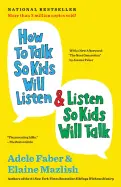
How to Talk So Kids Will Listen & Listen So Kids Will Talk - by Adele Fabe and Elaine Mazlish
ISBN: 1451663889Date read: 2016-08-17
How strongly I recommend it: 7/10
(See my list of 430+ books, for more.)
Go to the Amazon page for details and reviews.
Great thoughts on acknowledging kids' feelings.
my notes
When kids feel right, they’ll behave right. How do we help them to feel right? By accepting their feelings!
“You’re just saying that because you’re tired.” : Steady denial of feelings can confuse and enrage kids. Also teaches them not to know what their feelings are - not to trust them.
How do children feel when they have one’s feelings dismissed?
To help with feelings:
1. Listen with full attention.
2. Acknowledge their feelings with a word - “Oh” “Mmm” “I see”
3. Give their feelings a name.
4. Give them their wishes in fantasy.
When we urge a child to push a bad feeling away - however kindly - the child seems to get only more upset.
The child who hears the words for what she is experiencing is deeply comforted. Someone has acknowledged her inner experience.
Hold off on giving advice. Instead of giving advice, continue to accept and reflect on your child’s feelings.
The father hadn’t asked questions and yet the child had told him the whole story. He hadn’t given one word of advice, and yet the child had worked out his own solution, just by listening and acknowledging his feelings.
Equate the boy’s bruised, unhappy feelings with physical bruises. Give serious attention for his hurt feelings as he would for a hurt knee.
The question “Why?” only adds to their problem. In addition to their original distress, they must now analyze the cause and come up with a reasonable explanation.
At other times they’re reluctant to tell because they fear that in the adult’s eyes their reason won’t seem good enough. (“For that you’re crying?”)
It’s easier to talk to a grown-up who accepts what you’re feeling rather than one who presses you for explanations.
Children don’t need to have their feelings agreed with; they need to have them acknowledged. The statement “You’re absolutely right” might be satisfying to hear for the moment, but it can also prevent a child from thinking things through for himself.
To Engage Cooperation:
1. Describe. Describe what you see or describe the problem.
2. Give information.
3. Say it with a word.
4. Talk about your feelings.
5. Write a note.
It’s hard to do what needs to be done when people are telling you what’s wrong with you.
It’s easier to concentrate on the problem when someone just describes it to you.
When children are given information, they can usually figure out for themselves what needs to be done.
The shorter the reminder, the better.
Alternatives to Punishment:
1. Point out a way to be helpful.
2. Express strong disapproval (without attacking character).
3. State your expectations.
4. Show the child how to make amends.
5. Offer a choice.
6. Take action.
7. Allow the child to experience the consequences of his misbehavior.
To Problem-Solve:
1. Talk about the child’s feelings and needs.
2. Talk about your feelings and needs.
3. Brainstorm together to find a mutually agreeable solution.
4. Write down all ideas - without evaluating.
5. Decide which suggestions you like, which you don’t like, and which you plan to follow through on.
when people are placed in dependent positions, along with a small amount of gratitude they usually do experience massive feelings of helplessness, worthlessness, resentment, frustration, and anger.
To Encourage Autonomy:
1. Let children make choices.
2. Show respect for a child’s struggle.
3. Don’t ask too many questions.
4. Don’t rush to answer questions.
5. Encourage children to use sources outside the home.
6. Don’t take away hope.
Praise and Self-Esteem:
Instead of Evaluating (“Good” . . . “Great!” . . . “Fantastic!”), Describe.
1. Describe what you see.
“I see a clean floor, a smooth bed, and books neatly lined up on the shelf.”
2. Describe what you feel.
“It’s a pleasure to walk into this room!”
3. Sum up the child’s praiseworthy behavior with a word.
“You sorted out your Legos, cars, and farm animals, and put them in separate boxes. That’s what I call organization!”
To Free Children from Playing Roles
1. Look for opportunities to show the child a new picture of himself or herself.
2. Put children in situations where they can see themselves differently.
3. Let children overhear you say something positive about them.
4. Model the behavior you’d like to see.
5. Be a storehouse for your child’s special moments.
6. When your child behaves according to the old label, state your feelings and/or your expectations.